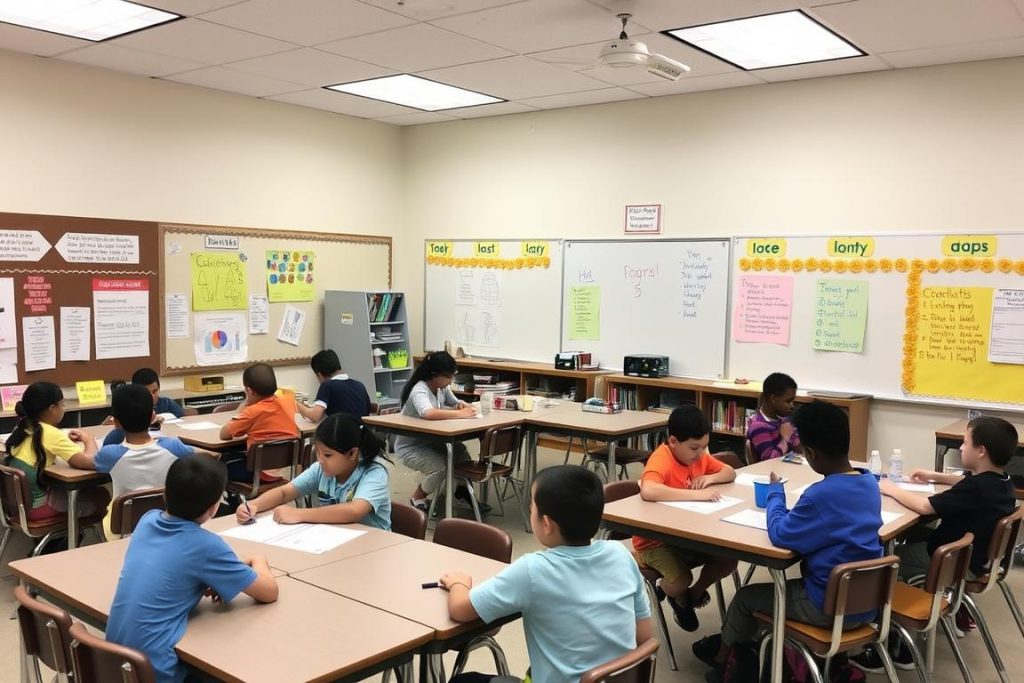Why Integrating Standards Matters for Student Success
When we teach standards in isolation, we miss valuable opportunities to help students see connections between concepts. Integrating standards isn’t just about efficiency—though that’s certainly a benefit. It’s about creating a more cohesive learning experience that mirrors how knowledge works in the real world.
According to research from Edutopia, students retain information better when they encounter it in multiple contexts. By deliberately integrating standards from different subject areas or within the same subject, you’re reinforcing key concepts while developing crucial teacher skills in curriculum design.
For example, when third-grade teachers introduce scaled bar graphs (a data standard) while teaching multiplication, students gain practice with multiplication facts in meaningful contexts. This approach builds connections between concepts, creating what educators call an “interconnected schema”—a web of related ideas that helps students remember and apply content more effectively.
Benefits of Integrating Standards:
- Creates meaningful connections between concepts
- Provides multiple contexts for practice
- Embeds content into long-term memory through spaced retrieval
- Allows for deeper exploration of topics
- Saves valuable instructional time
- Develops essential teacher skills in strategic planning
Understanding How Standards Are Designed for Integration
Most college and career-ready standards are intentionally designed with both across-grade and within-grade coherence. This means standards build upon each other grade after grade while also supporting one another within each grade level. Understanding this structure is a fundamental teacher skill that makes integrating standards more intuitive.
Many standards frameworks identify “major” or “focus” standards that represent the most critical work of a given grade. The remaining standards often reinforce these major standards. For example, in Common Core math, third-grade data standards (which are not considered major work) naturally support the major work of gaining fluency with multiplication facts.
By taking the time to analyze how your grade-level standards interconnect, you’ll discover natural integration points. This analysis is a valuable teacher skill that pays dividends in your instructional planning. Professional development in standards integration can help you master this analysis process more quickly.
While it may sound overwhelming to teach multiple standards at once, most college-and-career ready standards are designed to support such layering. Taking advantage of this design isn’t just efficient—it’s aligned with how the standards were meant to be taught.
ELA standards are particularly interconnected. For example, when students analyze a text’s theme, they naturally engage with standards related to character development, author’s craft, and text structure. Teaching these components in isolation actually diminishes their power and fails to reflect how real reading works.
Practical Strategies for Integrating Standards in Your Classroom
Moving from theory to practice requires specific strategies for integrating standards effectively. Here are proven approaches that can enhance both student learning and your teacher skills:
1. Map Your Standards Before Planning
Before diving into lesson planning, take time to map connections between standards. Look for natural overlaps and complementary skills. This mapping is a critical teacher skill that forms the foundation of effective integration.

Create a visual web of your grade-level standards, highlighting potential connections. For example, if you teach 4th grade, you might connect the standard for analyzing text structure with the standard for writing organized paragraphs. This visual mapping helps you see integration opportunities at a glance.
Teachers who want to develop this skill further can find structured guidance through professional development resources specifically designed for standards integration.
2. Use Content-Area Texts for Reading Instruction
Science and social studies provide excellent opportunities for integrating reading standards. Research shows that when students read content-area texts and apply that knowledge to problem-solving activities, they increase both content knowledge and reading comprehension.
For example, when teaching about ecosystems (science standard), have students read informational texts about different biomes. This naturally incorporates reading standards for informational text while reinforcing science content.
This integration requires teacher skills in selecting appropriate texts and designing questions that address both content knowledge and reading strategies. With practice, this approach becomes second nature.
3. Implement “Back-to-Front” Planning
Take content typically taught at the end of the year and introduce it earlier through intervention blocks or centers. This approach provides two key benefits:
- Students get spaced retrieval practice, which research shows enhances long-term memory
- When you reach that content in your regular sequence, students already have foundational knowledge, allowing for deeper instruction
For example, if data and graphing typically fall in your final math units, introduce these concepts during intervention blocks earlier in the year. Students can then practice these skills in centers even while the whole-class focus is on other standards.

4. Design Multi-Standard Projects
Project-based learning (PBL) offers a natural framework for integrating standards across subjects. Unlike traditional “dessert projects” that come after content is taught, true PBL uses the project as the vehicle for teaching the content.
For instance, a project where students create a field guide to local plants could integrate science standards (plant structures), writing standards (informational text), reading standards (research), and even math standards (measurement and data).
Developing effective multi-standard projects is an advanced teacher skill that improves with practice and professional support. Structured guidance on designing integrated projects can accelerate your proficiency in this area.
Assessing Student Learning When Integrating Standards
Assessment becomes both more complex and more authentic when you’re integrating standards. Traditional single-standard assessments may not capture the rich connections students are making. Here’s how to approach assessment effectively:

Create Multi-Dimensional Rubrics
Design rubrics that assess multiple standards simultaneously. For example, if students are writing opinion pieces about a scientific concept, your rubric might assess both writing standards (organization, evidence use) and science content knowledge.
Developing effective multi-standard rubrics is a specialized teacher skill that improves with practice. Start simple by combining just two related standards, then gradually increase complexity as your comfort level grows.
Use Performance Tasks
Performance tasks allow students to demonstrate mastery of multiple standards in authentic contexts. These tasks should:
- Reflect real-world applications
- Require integration of multiple skills
- Allow for different approaches to demonstrate mastery
- Provide clear evidence of student thinking
For example, rather than separate assessments for fraction operations and data analysis, create a performance task where students analyze survey data and represent it using fractions in various forms.
Implement Ongoing Formative Assessment
When integrating standards, formative assessment becomes even more crucial. Use strategies like:
- Exit tickets that address multiple standards
- Observational checklists tracking progress across integrated standards
- Student self-assessments of their understanding of connections
- Digital tools that allow quick checks for understanding
Mastering these assessment approaches requires developing specific teacher skills in both assessment design and data analysis. Many educators find that professional learning focused on integrated assessment significantly enhances their practice.
Overcoming Common Challenges When Integrating Standards
While integrating standards offers tremendous benefits, it also presents unique challenges. Here’s how to address common obstacles:

Challenge: Finding Time for Planning
Integrating standards effectively requires thoughtful planning—something many teachers are short on. To address this:
- Start small with just two naturally connected standards
- Use grade-level team meetings to plan integration collaboratively
- Leverage existing resources that have already mapped connections
- Develop a library of integrated lessons you can reuse and refine
Efficient planning is a teacher skill that develops over time. Many educators find that structured professional development helps them develop systems that make integration planning more manageable.
Challenge: Maintaining Depth of Instruction
There’s a risk that integration could lead to superficial coverage of multiple standards rather than deep learning. To ensure depth:
- Focus on meaningful connections rather than forced ones
- Ensure your primary standard receives full instructional attention
- Use supporting standards to enhance, not dilute, the primary learning
- Check that assessment truly measures depth of understanding
Challenge: Navigating Required Curriculum Materials
Many teachers must use district-adopted curriculum materials that may not be designed for integration. Here’s how to work within these constraints:
- Analyze your materials to identify natural connection points
- Use required materials as a foundation, then supplement with integrated activities
- Resequence components when possible to create better integration opportunities
- Share successful integration strategies with colleagues using the same materials
Developing the teacher skills to adapt curriculum materials while meeting requirements is valuable professional growth. Resources like Integrating Standards Effectively can provide structured guidance for this process.
Developing Your Teacher Skills Through Integrating Standards
The process of learning to integrate standards effectively is itself a powerful professional growth opportunity. As you develop this approach, you’ll strengthen several essential teacher skills:

Curriculum Analysis
You’ll develop a deeper understanding of how standards connect both within and across grade levels. This analytical skill helps you make better instructional decisions and communicate learning progressions to students and parents.
Instructional Design
Creating integrated learning experiences strengthens your lesson design skills. You’ll become more adept at crafting engaging, multi-layered activities that address diverse learning needs while maintaining curricular coherence.
Assessment Literacy
As you design assessments for integrated standards, you’ll develop more sophisticated approaches to measuring student learning. This enhanced assessment literacy improves your ability to gather meaningful data and use it to inform instruction.
Adaptive Expertise
Perhaps most importantly, integrating standards develops your adaptive expertise—the ability to apply professional knowledge flexibly in diverse situations. This is among the most valuable teacher skills for long-term success.
Ready to Master Standards Integration?
Take your teacher skills to the next level with our comprehensive professional development resource. “Integrating Standards Effectively” provides structured guidance, practical templates, and expert strategies to help you implement this powerful approach in your classroom.
Start Small, Think Big: Your Path to Integrating Standards
Integrating standards isn’t an all-or-nothing proposition. Even small steps toward more connected teaching can yield significant benefits for both you and your students. Begin by identifying just one or two natural connections in your upcoming units. As your teacher skills in this area develop, you can gradually expand your approach.
Remember that the goal isn’t to force connections where they don’t exist, but to leverage the natural relationships between standards to create more meaningful, efficient learning experiences. By thoughtfully integrating standards, you’re not just “covering” curriculum—you’re helping students build the connected understanding they need for long-term success.
The journey toward effective standards integration is ongoing professional growth. Each attempt teaches you something valuable about curriculum design, student learning, and your own teacher skills. Embrace the process, celebrate small wins, and keep refining your approach.
Ready for more strategies to enhance your teaching practice? Visit Credits for Teachers for additional resources designed to support your professional growth journey.




